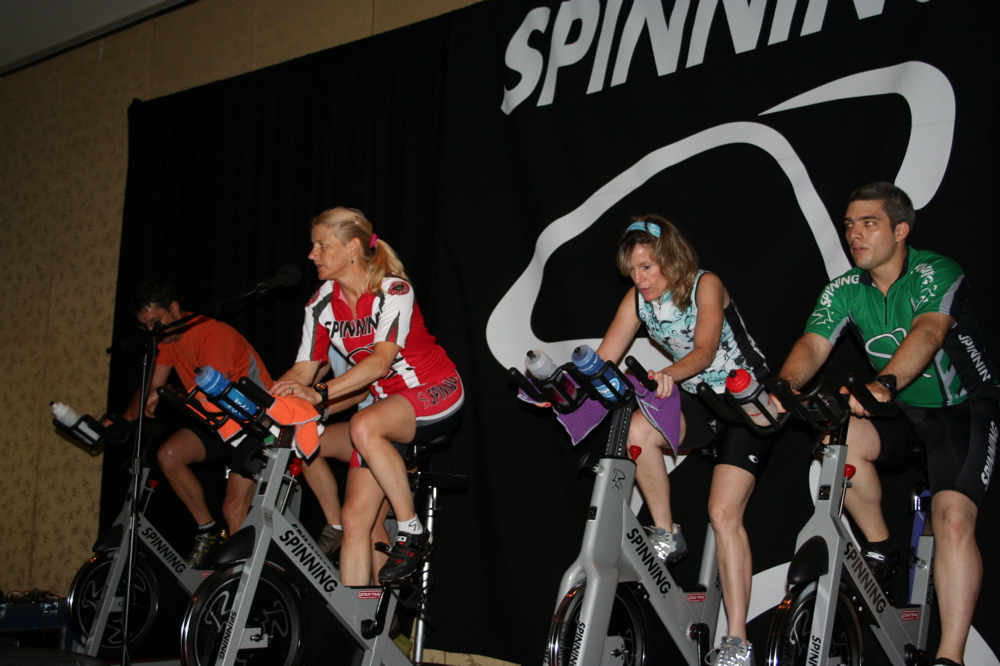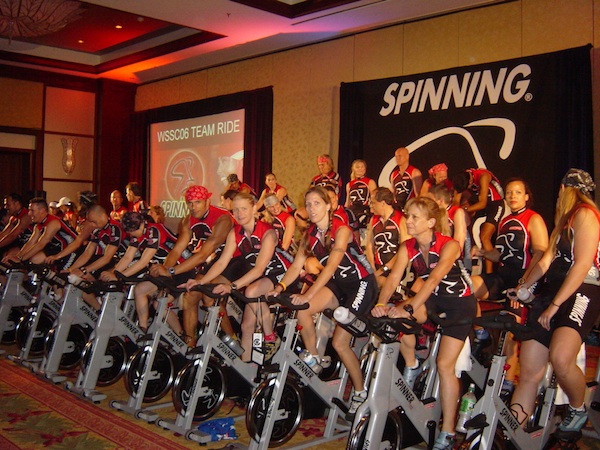You may know that Jennifer Sage has been educating and inspiring cycling instructors at live workshops and conferences internationally for 18 years. But there are probably some things you don’t know about Jennifer’s history in indoor cycling.
Twelve of those years presenting were exciting years with Mad Dogg Athletics and Spinning®. The very first World Spinning and Sports Conference was in 1999 in Santa Monica, California. At first, most of the conference sessions only addressed official Spinning Energy Zones® and the core movements of Spinning, or the mind-body connection employed by Johnny G.
In 2000, Jennifer asked Joelle Mancuso, the education director for Spinning, why they didn’t do some things in Spinning classes that were more typical in outdoor riding. Joelle told her that if she wanted to teach it, she should create a conference session around it. That was the genesis of so many of Jennifer’s workshops—they all came from her experience riding outside. She began presenting in 2001 at WSSC Miami and Chicago, and continued through 2009. She also presented at numerous other conferences for MDA, including ECA Florida, ECA New York, Can Fit Pro in Toronto, Crunch, TSI Summit, and more.
In her last five years of presenting at WSSC, Jennifer’s sessions regularly taught to sold-out crowds, with long lines out the door waiting to audit the sessions.
Several conference sessions she created were innovative and groundbreaking in the indoor cycling world. She was the first to present numerous topics that brought the outdoor cycling world indoors and utilized coaching and training techniques employed by top cycling coaches such as Joe Friel, Chris Carmichael, Hunter Allen, and more. These sessions were unique at the time because they were not just a Spinning® Energy Zone® profile; in fact, they were the first to appear at any major fitness conference.
The following cycling-specific and science-based sessions written and presented by Jennifer all represent “firsts” in the indoor cycling education community:
- Contraindications in Spinning®. The term “contraindications” was first used in indoor cycling by Jennifer in her WSSC workshop in 2001. She later rewrote this session to become the Mad Dogg Athletics Contraindications in Spinning continuing education workshop in 2004.
- Keep it Real, 2006. Jennifer was the first to adopt the term Keep it Real in indoor cycling (now one of her signature sayings). This session was a modification of her Contraindications WSSC workshop, and in 2008 it became the title of her e-book. It is now the foundation for everything she teaches, as well as a movement in the indoor cycling community for instructors who adhere to science-based cycling.
- The Anatomy of the Pedal Stroke, 2002–2004. This was the first session to address the biomechanics of the pedal stroke indoors and to employ drills to enhance the pedal stroke.
- A Beautiful Mind Body, 2005. The first workshop to break down the cadence and resistance relationship and their combined effect on intensity, and introduce the concept of power long before power meters became popular in indoor classes. The session title was a play on words from the movie A Beautiful Mind, and examined the theoretical mathematical relationship of C X R = I (Cadence X Resistance = Intensity, the application of the “power” equation as it relates to indoor cycling), as well as the mind’s role in affecting intensity. She modified this workshop to become the MDA Cadence, Heart Rate, and Resistance continuing education workshop a year later.
- Rolling Hills and Switchbacks, 2002–2003. It’s surprising, but this was the first Spinning profile at a major conference employing rolling hills and switchbacks. Before that, climbing profiles at WSSC were typical “Strength Energy Zone” rides with constant resistance, jumps on a hill, runs with resistance, and sprints on a hill. How to teach real-world climbing terrain such as switchbacks or short, steep rollers had not been addressed before 2002 at WSSC.
- Marrakesh Express, a Tempo Ride, 2005. “Tempo” is a term commonly used by outdoor cyclists for moderate aerobic training sessions. This was the first “tempo” ride at 80% MHR (sub-threshold), which at the time was higher than the accepted Spinning Endurance Energy Zone® ceiling of 75% MHR. The title came from the entrancing global music from Cairo to Casablanca to India played during the ride.
- Pacelines and Cadence Drills, 2002–2003. Now ubiquitous in classes around the world, this was the first session at any conference to teach instructors how to simulate pacelines indoors and to perform cadence drills.
- Criteriums, 2003–2004. This exciting session was a definitive break from the typical Race Day Energy Zone® format taught at the time. The Spinning Race Day was (still is) always taught as a time trial. Jennifer thought, “Why not do a criterium, a fast-paced race in multiple laps usually around a city center?” It was a hit!
- Heart Rate Pyramid, 2003–2005. Ladder profiles were just being introduced; this session was the first to do a heart rate pyramid with incremental, measured increases in intensity.
- The Tour de France and Alpe d’Huez, 2003–2009. Jennifer was the first Master Instructor to teach how to simulate a stage of the Tour and create an entire Tour de France program. The Alpe d’Huez profile was also unique in its approach in that it is a story told through the eyes of a domestique in the Tour faced with the possibility of not succeeding on this epic climb after suffering through numerous previous climbs on a long stage. She later added another TDF stage simulation called The Suitcase of Courage, named after an analogy used by the iconic TDF announcer Phil Liggett when describing the courage cyclists needed to take with them in the race.
- The Lactate Threshold Field Test, 2007–2009. Before Jennifer introduced this field test to estimate lactate threshold (LT) and determine threshold-based zones (based primarily on Joe Friel’s LTHR-based zones), maximum heart rate had been the only way to determine training zones in the Spinning program. (Note: MHR is still the “official” method taught by MDA.)
- The Triple Threat, 2007–2009. While intervals were commonly taught, they were generally haphazard hard efforts followed by recovery, a basic “HIT” session. The Triple Threat introduced the concept that not all intervals are created equal. It is based on LT heart rates and addresses the physiological adaptations of three different kinds of high-intensity intervals—lactate threshold, VO2 max, and lactate tolerance intervals. That kind of physiological specificity had not been addressed previously anywhere in indoor cycling education.
- Moving Mountains, 2005–2009. Jennifer was the first Master Instructor who dared teach a two-hour seated climb, simulating what it’s really like to climb an epic mountain outdoors. Living in Colorado, it was only natural to sit on a climb for two hours—why not develop the mental tenacity needed for such an endeavor? The session also taught the practical application of the concept of Flow, or being one with the bike.
Other popular conference sessions of Jennifer’s were not new concepts but were either groundbreaking in their application or simply added a new twist to an old concept. These include the following:
- Spinning as Dynamic Meditation, 2001, 2004. Johnny G was the master at employing a mind-body approach. Jennifer took that idea and broke it down into a veritable moving meditation session. This workshop early in her career established her as an MI who was effective at teaching instructors to bring the mental connection to their own classes.
- Loop de Loop, 2004–2007. Loop classes weren’t new, but a mountain bike application was. This session is noted by some as one of Jennifer’s most popular profiles she ever created. It introduced the concept of “The Stairs”—a series of short steep/steeper climbs in and out of the saddle (as one might encounter on a real mountain bike trail) that is now commonly employed in profiles around the world.
- The Suitcase of Courage, 2008. This was a more generic stage of the Tour de France that taught how to simulate attacks, breakaways, and the peloton reeling in the breakaway cyclists. The title comes from a colorful metaphor used by Phil Liggett, a pro-cycling commentator known as the “voice of cycling,” to describe what a cyclist needs to carry with him to succeed in a bike race.
- The Secret Ride, 2008. Another mind-body session, this one inspired riders to dig deep inside to set goals and light their passion on fire and make things happen in their lives—not just their fitness goals, but to transcend the cycling studio and apply these skills to other areas in life. The ride was based on the concept of the book The Secret, which taught that we create our own reality.
- How Big is Your Why, 2009. The Secret Ride morphed into a deeper examination of goal setting by uncovering and emphasizing the most compelling reasons for wanting to accomplish our goals—your “Why.” Once you uncover your biggest Why, goals seem to fall in place!
- Strategies of Strength,2009. What strategies, both mental and physical, do outdoor cyclists employ to help them get up the longest, most grueling climbs? Having ridden her bike up some of the most challenging climbs in Europe, New Zealand, and across the US, Jennifer brought these strategies to the indoor cycling world.
- Energia Magica, 2010. The ultimate in visualization. If you’ve ever ridden your bike through different topographies, from desert to country, forest, ocean, or lakeside, you realize that there is a different magical energy given off by different elements in nature. This ride describes one long, epic climb through different zones, where you draw your inspiration and energy from the nature around you to help you reach the summit. You also learn to share your energy with your riding partner.
The live workshops available at ICA are those that she has researched and developed herself throughout her years of presenting and her experience training and coaching. Jennifer realized what was missing from indoor cycling education and has developed science-based and cycling-based workshops to meet those needs, while also teaching instructors the coaching skills required to share these concepts effectively with their students.
These topics are also the basis for the education provided to members of the Indoor Cycling Association.


